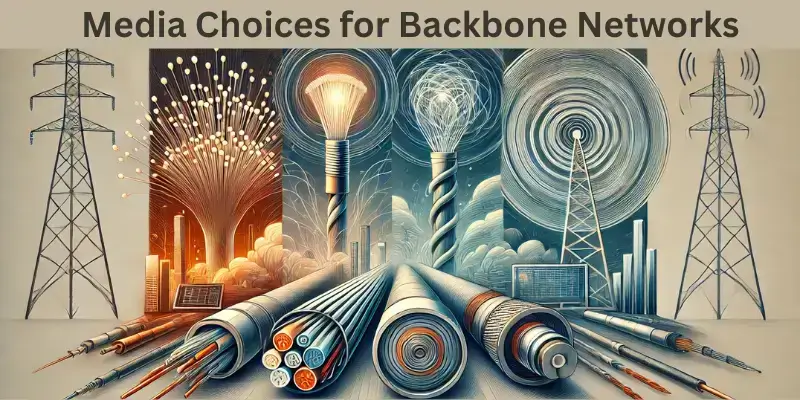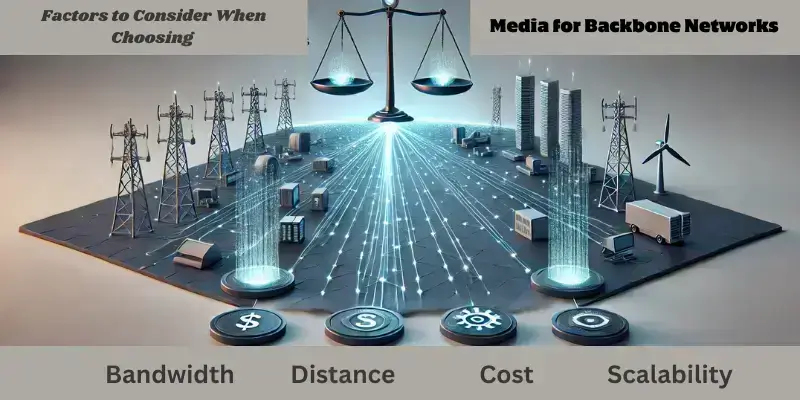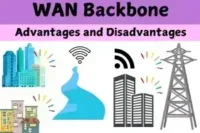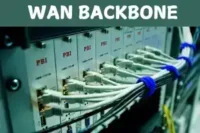Media Choices for Backbone Networks
Published: January 26, 2025
Media Choices for Backbone Networks: If you’re frustrated with slow internet speeds or spotty connections, it’s not your router or provider to blame. The real culprit might lie in the backbone network—the infrastructure that connects all networks. Poor performance at this level can lead to network congestion, delays, and unreliable service. Understanding backbone networks can help you realize why these issues happen and what can be done to solve them.

Factors to Consider When Choosing Media for Backbone Networks
Now, discuss in detail the Factors to consider when choosing media for backbone networks.
Bandwidth Requirements
Consider the volume of data the network will handle. Fiber optics are ideal for high-bandwidth applications, while twisted pair cables suffice for smaller networks.
Distance
Fiber optics are the preferred choice for long-distance connections, while twisted pair and coaxial cables are better suited for shorter distances.
Cost
Evaluate the network budget. While fiber optics offer superior performance, twisted pair cables are more affordable for smaller setups.
Scalability
Choose media that can accommodate future network growth. Fiber optics and hybrid systems are highly scalable.
Environment
Consider environmental factors such as interference, temperature, and physical obstacles. Fiber optics resist EMI, while wireless technologies are ideal for challenging terrains.

Types of Media Used in Backbone Networks
Backbone networks rely on different types of transmission media. Let’s now discuss each transmission media, its advantages, and limitations.
1. Fiber Optic Cables
Fiber optic cables are one of the most popular and reliable media for backbone networks. They use light to transmit data, offering incredibly high speeds and bandwidth. These cables are made of glass or plastic fibers designed to carry data over long distances without significant loss.
Advantages
High Bandwidth
Fiber optic cables support data transmission up to several terabits per second, making them ideal for data-intensive applications like video streaming and cloud computing.
Long Distance
Unlike other media, fiber optics can transmit data over vast distances (up to 60 miles for single-mode fibers) without signal degradation.
Resistance to Interference
Since fiber optics transmit data via light, they are immune to electromagnetic interference (EMI), ensuring reliable communication in environments with high electrical noise.
Future-Proof
With increasing demand for bandwidth, fiber optics remain the preferred choice for scalable and future-ready backbone networks.
Disadvantages
Cost
The initial installation and equipment for fiber optics are expensive compared to other media.
Fragility
The glass or plastic fibers are delicate and require careful handling during installation and maintenance.
Specialized Skills
Deploying and maintaining fiber optic networks require trained professionals, which can increase operational costs.
Applications
- Data centers
- Wide Area Networks (WANs)
- Cloud-based services
2. Twisted Pair Cables
Twisted pair cables are commonly used in smaller networks and offer a cost-effective solution for connecting devices. These cables consist of two insulated copper wires twisted together to reduce electromagnetic interference.
Advantages
Cost-Effective: Twisted pair cables are affordable and widely available, making them a good choice for budget-conscious networks.
Ease of Installation
These cables are lightweight, flexible, and easy to install, especially in existing infrastructures.
Compatibility
Twisted pair cables are compatible with standard Ethernet protocols, making them versatile for various applications.
Disadvantages
Limited Bandwidth
Compared to fiber optics, twisted pair cables have lower bandwidth and cannot handle large data loads efficiently.
Short Distance
These cables are suitable for short-distance communication (up to 100 meters) and may require signal boosters for longer connections.
Susceptible to Interference
The twisted pair cables are vulnerable to EMI and crosstalk despite the twisting mechanism.
Applications
- Local Area Networks (LANs)
- Small office setups
- Residential internet connections
3. Coaxial Cables
Coaxial cables are older media that still find applications in specific backbone networks. They consist of a central copper conductor, an insulating layer, a metallic shield, and an outer plastic sheath.
Advantages
High Resistance to Interference
The metallic shield protects the signal from external interference, ensuring reliable communication.
Durability
Coaxial cables are robust and can withstand physical wear and tear better than many other media.
Cost-Effective
Coaxial cables remain an affordable option for specific use cases, such as connecting legacy systems.
Disadvantages
Limited Bandwidth
Coaxial cables cannot handle high data rates compared to fiber optics or advanced twisted pair cables.
Bulkiness
These cables are thick and less flexible, making installation more challenging.
Outdated
With the advent of more advanced technologies, coaxial cables are rarely used in modern backbone networks.
Applications
- Legacy systems
- Cable TV networks
- Specialized industrial applications
4. Wireless Technologies
Wireless technologies, such as microwave, satellite, and Wi-Fi, are becoming increasingly popular in backbone networks, especially when laying cables is impractical or costly.
Advantages
Flexibility
Wireless networks are not constrained by physical cables, allowing for easy scalability and adaptability.
Cost-Effective for Remote Areas
Wireless technologies provide an efficient alternative in locations where laying cables is expensive or impossible.
Rapid Deployment
Wireless backbone networks can be set up more quickly than wired alternatives.
Disadvantages
Limited Bandwidth
Wireless networks typically offer lower data transmission rates than fiber optics.
Interference Issues
Wireless signals are susceptible to interference from weather conditions, physical obstacles, and other electronic devices.
Security Concerns
Wireless networks are more vulnerable to hacking and require robust encryption to ensure data safety.
Applications
- Remote and rural areas
- Disaster recovery networks
- Temporary setups like event venues
5. Hybrid Systems
Hybrid systems combine multiple media types, such as fiber optics, twisted pair cables, and wireless technologies, to create a versatile and resilient backbone network. These systems leverage the strengths of each medium to optimize performance.
Advantages
Versatility
Hybrid systems can be tailored to meet specific network requirements by combining different media.
Cost Optimization
Hybrid systems balance performance and cost by using the right media for the proper purpose.
Resilience
If one medium fails, the network can switch to an alternative, ensuring uninterrupted communication.
Disadvantages
Complexity
Managing and maintaining a hybrid system requires careful planning and expertise.
Higher Initial Costs
The integration of multiple media types can increase the upfront cost of deployment.
Applications
- Large enterprise networks
- Smart cities
- Integrated IoT systems
Comparison of Media Types for Backbone Networks
Fiber Optic vs. Copper Cable(including twisted pair and coaxial cables)
Fiber optics provide significantly higher speed, longer distances, and more excellent reliability than copper cables, which are more vulnerable to signal loss and interference. While fiber optics have a higher initial cost, they are more future-proof and cost-effective over time.
Wired vs. Wireless
Wired media like fiber optics generally offer more stable connections. Still, wireless options like 5G and Wi-Fi can provide flexibility and ease of installation, especially in dynamic or hard-to-wire environments.
Cost-Benefit Analysis
When comparing media types, it’s essential to consider not only the initial cost but also the long-term costs, such as maintenance, energy consumption, and potential for network upgrades.
Due to their high capacity, fiber optic cables are the most commonly used type of media in backbone networks. They offer high bandwidth, low latency, and minimal signal degradation over long distances, making them ideal foreseen networks.
Future Trends in Backbone Network Media
The future of backbone networks is evolving rapidly with new technologies:
Emerging Technologies
Innovations like 5G networks, quantum computing, and advanced fiber optics are reshaping backbone networks. These technologies promise to offer even higher speeds, lower latencies, and more efficient data transmission.
Integration with IoT and Smart Cities
As the Internet of Things (IoT) and smart cities become more prevalent, backbone networks will need to support many devices and sensors, requiring faster and more robust media choices.
Conclusion
Choosing the right media for backbone networks is a critical decision that impacts the entire network’s performance, scalability, and reliability. Fiber optic cables are the gold standard for high-speed, long-distance communication, while twisted pair and coaxial cables are cost-effective alternatives for smaller networks. Wireless technologies offer flexibility in remote areas, and hybrid systems provide the best of all worlds. By understanding each medium’s unique features, advantages, and limitations, you can design a backbone network that meets your specific needs and supports future advancements.
FAQs About Media Choices for Backbone Networks
Fiber optics offer much higher bandwidth, meaning they can transfer more data faster than copper cables. Copper cables, while cheaper, are slower and have more interference, making them less ideal for high-capacity backbone networks.
A backbone network connects different networks, usually over long distances, while a LAN connects devices within a smaller area like an office or home. Backbone networks handle more significant amounts of data and have higher performance needs.
While wireless media can be used, they are less reliable and slower than fiber optics, which are usually preferred for backbone networks due to their higher speed and reliability over long distances.
Not entirely. Copper cables, like twisted pairs and coaxial cables, are still used in some older backbone networks or for shorter distances. However, they can’t match the speed and capacity of fiber optics in modern, high-demand networks.
While Wi-Fi and 5G are excellent for flexibility, they don’t offer the same speed, stability, or range as fiber optics. Backbone networks must support massive data traffic over long distances, which wireless technologies can struggle with.
Latency refers to the delay in data transmission between two points. In backbone networks, lower latency is crucial for faster communication, so fiber optics are often preferred for minimizing delays.
Environmental factors like weather, terrain, or urban areas can impact the performance of certain media. For example, rain or obstacles can affect wireless media like microwave transmission, while fiber optics are less affected by these factors.
The initial cost of installing fiber optic cables can be high, so some networks stick with older technologies like copper cables. However, as demand for higher speeds increases, more networks are shifting to fiber optics for future-proofing.
Yes, many backbone networks use a combination of media types. For instance, fiber optics might be used for long-distance connections, while copper cables or wireless solutions might be used for shorter connections or specific applications.
The right media ensures the network runs smoothly, supports enough data capacity, and stays reliable. Choosing poorly can lead to slow speeds, outages, or inefficient data flow, hurting overall performance.





